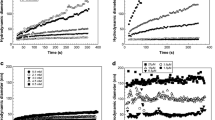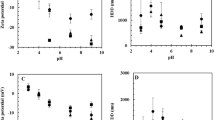Abstract
Predicting the aggregation tendency of nanoscale zero-valent iron (nZVI), oxidized nZVI, in particular, is crucial for the risk assessment of nZVI in aquatic environments. In this study, the comprehensive effects of the pH and ionic strength (IS) on the aggregation behaviors of two highly oxidized nZVIs (HO-nZVI) were examined. Compared with hematite nanoparticles, HO-nZVI presented a sudden acceleration in aggregation under critical conditions; moreover, the morphology of the HO-nZVI aggregates at pH and IS values higher or lower than the critical conditions was significantly different. Furthermore, owing to the differences in magnetization between the two prepared HO-nZVI samples, their critical coagulation conditions were significantly different. The significant changes in the aggregation behavior of the HO-nZVI samples were analyzed using colloidal theories, and the aggregation tendency of HO-nZVI under specific conditions could be simulated by calculating the theoretical critical conditions of aggregation via a method that takes into account the hydrochemical properties, magnetization, and surface charge of HO-nZVI. To examine the correctness of the method, we compared the experimentally determined colloidal stability of HO-nZVI in water samples collected from nearby rivers with the theoretically predicted value. The results indicated that the method was adequate for most situations, except for those in which the hydrochemical properties of the water samples were close to the critical coagulation conditions. Our study proposes a theoretical approach that is viable for simulating the colloidal stability of magnetic nanoparticles in aquatic environments; we anticipate that it will further facilitate the risk assessment of nanoparticles.





Similar content being viewed by others
References
Arshadi M, Soleymanzadeh M, Salvacion JWL, SalimiVahid F (2014) Nanoscale zero-valent iron (NZVI) supported on sineguelas waste for Pb(II) removal from aqueous solution: kinetics, thermodynamic and mechanism. J. Colloid. Interf. Sci. 426:241–251
Baalousha M, Manciulea A, Cumberland S, Kendall K, Lead JR (2008) Aggregation and surface properties of iron oxide nanoparticles: influence of pH and natural organic matter. Environ Toxicol Chem 27:1875–1882
Cohen M, Weisbrod N (2018) Transport of iron nanoparticles through natural discrete fractures. Water Res 129:375–383
Dwivedi S, Siddiqui MA, Farshori NN, Ahamed M, Musarrat J, Al-Khedhairy AA (2014) Synthesis, characterization and toxicological evaluation of iron oxide nanoparticles in human lung alveolar epithelial cells. Colloid Surf B 122:209–215
Eglal MM, Ramamurthy AS (2015) Removal of Pb (II), Cd (II), Cu (II) and trichloroethylene from water by nanofer ZVI. Environ Sci Heal A 50:901–912
Ghosh I, Mukherjee A, Mukherjee A (2017) In planta genotoxicity of nZVI: influence of colloidal stability on uptake, DNA damage, oxidative stress and cell death. Mutagenesis 32:371–387
Jiang D, Hu X, Wang R, Yin D (2015) Oxidation of nanoscale zero-valent iron under sufficient and limited dissolved oxygen: influences on aggregation behaviors. Chemosphere 122:8–13
Jiang D, Hu X, Wang R, Wang Y, Yin D (2016) The decreasing aggregation of nanoscale zero-valent iron induced by trivalent chromium. Environ Chem 14
Jiao WZ, Qin YJ, Luo S, He Z, Feng ZR, Liu YZ (2017) Simultaneous formation of nanoscale zero-valent iron and degradation of nitrobenzene in wastewater in an impinging stream-rotating packed bed reactor. Chem Eng J 321:564–571
Lei C, Sun Y, Tsang DCW, Lin D (2018) Environmental transformations and ecological effects of iron-based nanoparticles. Environ Pollut 232:10–30
Li S, Wang W, Yan W, Zhang W-x (2013) Nanoscale zero-valent iron (nZVI) for treatment of concentrated Cu (II) wastewater a field demonstration. Environ Sci Proc Imp 16:524–533
Li ZF, Dong HP, Zhang YL, Li JF, Li YM (2017) Enhanced removal of Ni(II) by nanoscale zero valent iron supported on Na-saturated bentonite. J Colloid Interf Sci 497:43–49
Liu J, Liu A, Zhang WX (2016) The influence of polyelectrolyte modification on nanoscale zero-valent iron (nZVI): aggregation, sedimentation, and reactivity with Ni(II) in water. Chem Eng J 303:268–274
Llaneza V, Rodea-Palomares I, Zhou Z, Rosal R, Fernández-Pina F, Bonzongo JCJ (2016) Polyvinylpyrrolidone and arsenic-induced changes in biological responses of model aquatic organisms exposed to iron-based nanoparticles. J Nanopart Res 18:1–12
Martin JE, Herzing AA, Yan WL, Li XQ, Koel BE, Kiely CJ, Zhang WX (2008) Determination of the oxide layer thickness in core-shell zerovalent iron nanoparticles. Langmuir 24:4329–4334
Mueller NC, Braun J, Bruns J, Cernik M, Rissing P, Rickerby D, Nowack B (2012) Application of nanoscale zero valent iron (NZVI) for groundwater remediation in Europe. Environ Sci Pollut Res 19:550–558
Ohshima H (2012a) Electrical phenomena at interfaces and biointerfaces: fundamentals and applications in nano-, bio-, and environmental sciences. Wiley, Hoboken
Ohshima H (2012b) Potential and charge of a hard particle and a soft particle, electrical phenomena at interfaces and biointerfaces. John Wiley & Sons, Inc., pp. 1-15
Phenrat T, Saleh N, Sirk K, Tilton RD, Lowry GV (2007) Aggregation and sedimentation of aqueous nanoscale zerovalent iron dispersions. Environ Sci Technol 41:284–290
Prabu D, Parthiban R, Ponnusamy SK, Anbalagan S, John R, Titus T (2017) Sorption of cu(II) ions by nano-scale zero valent iron supported on rubber seed shell. Iet Nanobiotechnol 11:714–724
Rosicka D, Sembera J (2011) Influence of structure of iron nanoparticles in aggregates on their magnetic properties. Nanoscale Res Lett 6:1–9
Tosco T, Papini MP, Viggi CC, Sethi R (2014) Nanoscale zerovalent iron particles for groundwater remediation: a review. J Clean Prod 77:10–21
Wang W, Hua YL, Li SL, Yan WL, Zhang WX (2016) Removal of Pb(II) and Zn(II) using lime and nanoscale zero-valent iron (nZVI): a comparative study. Chem Eng J 304:79–88
Wang H, Zhao XL, Han XJ, Tang Z, Liu SS, Guo WJ, Deng CB, Guo QW, Wang HH, Wu FC, Meng XG, Giesy JP (2017) Effects of monovalent and divalent metal cations on the aggregation and suspension of Fe3O4 magnetic nanoparticles in aqueous solution. Sci Total Environ 586:817–826
Yang YF, Cheng YH, Liao CM (2016) In situ remediation-released zero-valent iron nanoparticles impair soil ecosystems health: a C. elegans biomarker-based risk assessment. J. Hazard. Materials. 317:210–220
Yin K, Lo IMC, Dong H, Rao P, Mak MSH (2012) Lab-scale simulation of the fate and transport of nano zero-valent iron in subsurface environments: aggregation, sedimentation, and contaminant desorption. J Hazard Materials 227–228:118–125
Yirsaw BD, Megharaj M, Chen ZL, Naidu R (2016) Environmental application and ecological significance of nano-zero valent iron. J Environ Sci 44:88–98
Zhu MT, Wang B, Wang Y, Yuan L, Wang HJ, Wang M, Ouyang H, Chai ZF, Feng WY, Zhao YL (2011) Endothelial dysfunction and inflammation induced by iron oxide nanoparticle exposure: risk factors for early atherosclerosis. Toxicol Lett 203:162–171
Zou YD, Wang XX, Khan A, Wang PY, Liu YH, Alsaedi A, Hayat T, Wang XK (2016) Environmental remediation and application of nanoscale zero-valent iron and its composites for the removal of heavy metal ions: a review. Environ. Sci. Technol. 50:7290–7304
Acknowledgments
We sincerely thank Prof. Weixian Zhang and his team at Tongji University for providing the nZVI for our study. We would like to thank Editage (www.editage.cn) for English language editing.
Funding
This work was jointly supported by the Foundation of Shaanxi Educational Committee (No. 19JK0398 and 17JK0380), State Key Laboratory of Pollution Control and Resource Reuse Foundation, (No. PCRRF17017), and the National Natural Science Foundation of China (No. 21807085).
Author information
Authors and Affiliations
Corresponding author
Ethics declarations
Conflict of interest
The authors declare that they have no conflicts of interest.
Additional information
Responsible editor: Philippe Garrigues
Publisher’s note
Springer Nature remains neutral with regard to jurisdictional claims in published maps and institutional affiliations.
Electronic supplementary material
ESM 1
(DOCX 238 kb)
Rights and permissions
About this article
Cite this article
Jiang, D., Jin, X., Ma, A. et al. Predicting the aggregation tendency of oxidized nanoscale zero-valent iron in aquatic environments. Environ Sci Pollut Res 27, 44177–44182 (2020). https://doi.org/10.1007/s11356-020-10337-7
Received:
Accepted:
Published:
Issue Date:
DOI: https://doi.org/10.1007/s11356-020-10337-7




